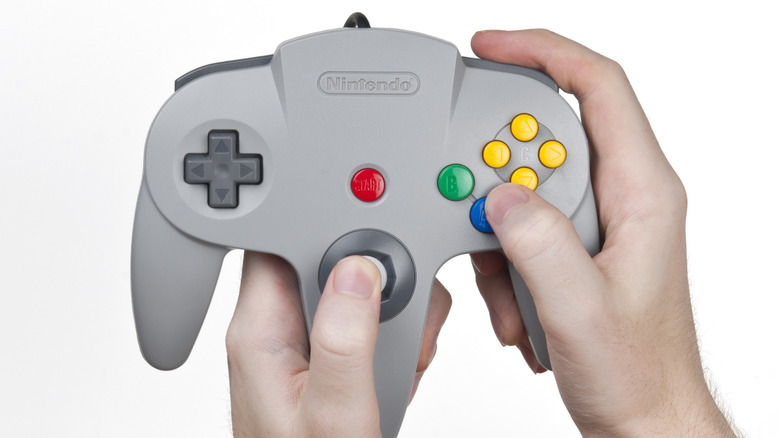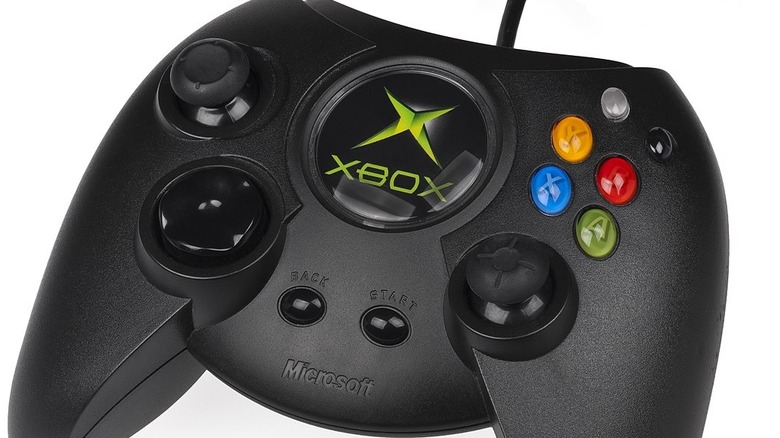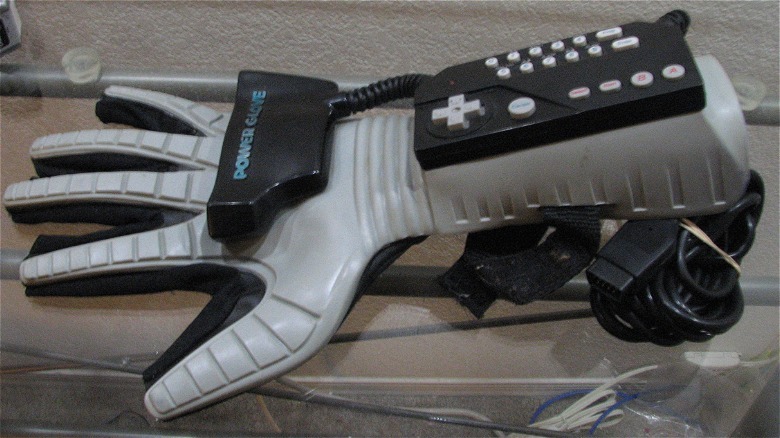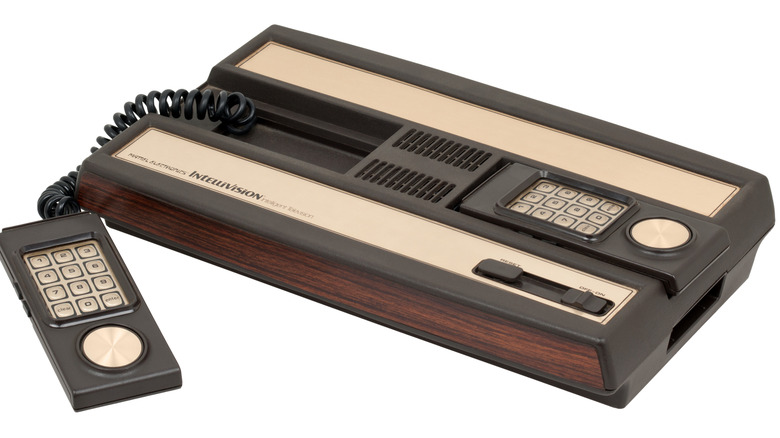5 Of The Worst Controllers Ever Made For A Gaming Console
Video games are all about controlling the on-screen action of your television via some kind of input device. A console can live and die by the features of its controller. The Nintendo 64 controller, while an unwieldy beast and unorthodox in design (to say the least), had a magnificent analog stick that made games like Super Mario 64 feel like one-of-a-kind experiences that couldn't be replicated on any other console. Nintendo themselves tried on the Nintendo DS and its remake, Super Mario 64 DS, but the results, while admirable, just weren't the same.
Some controllers are absolutely perfect, like the Nintendo GameCube controller, which just got a revival on the Nintendo Switch, and the PlayStation DualSense, which evolved the classic DualShock to the next level with haptic feedback, adaptive triggers, and other additions that make it feel like the culmination of five generations of PlayStation hardware.
However, others weren't so lucky, like the Sega Dreamcast controller. While the Dreamcast itself is fondly remembered, the limitations of the controller (only having one analog stick was a huge mistake) meant Sega's final console was never going to be able to keep up with the competition and was doomed to "cult favorite" status. And some controllers, well, they're just bizarre. Let's take a walk down memory lane and look at five of the worst controllers ever made for a gaming console.
Xbox Duke
Microsoft's first foray into the video game console space was with the original Xbox, a console that stumbled out of the gate until "Halo" became a LAN staple and launched one of the all-time great FPS franchises. However, even with the success of "Halo," there was still one problem plaguing the early days of the Xbox (other than the lack of noteworthy games other than Halo).
The original Xbox launched with one of the most infamous controllers ever made, which was affectionately nicknamed "The Duke," though it looked more like a radioactive cheeseburger. The controller was an absolute unit, colossal in size and with weirdly italicized face buttons. It was reasonably comfortable to hold, since its impressive size meant your fingers would never be scrunched up, but always stretched out just to reach the buttons.
However, for little kids or those with smaller hands, the Duke controller was all but impossible to use. Fortunately, Microsoft course-corrected and released the more compact "Controller S" in 2002, which made the Xbox more palatable for mass, younger audiences. Still, some people have a degree of nostalgia for the bulky original controller, to the point where Hyperkin released an officially licensed "Duke" controller to celebrate Xbox's 20th anniversary.
Nintendo Power Glove
Long before VR headsets and the Xbox Kinect, Nintendo tried their 'hand' at motion controls with the Power Glove, a wearable controller that allowed players to control their NES games via the motion of their hand ... theoretically. In practice, the Power Glove was almost unusable.
Two games, "Super Glove Ball" and "Bad Street Brawler," were designed with the Power Glove in mind, but any game was technically compatible with the accessory. In this case, 'compatible' is a relative term, since the Power Glove almost never worked as it was intended, and you wound up flailing your arm like a lunatic before hitting a 'game over' screen.
The Power Glove was featured in the cult classic 1989 film "The Wizard,"where a character using the device says, "I love the Power Glove. It's so bad." In any case, Nintendo would have much greater success with their next attempt at motion controls: the 2006 Wii console, the success of which kick-started a wave of motion controls that included the PlayStation Move and Xbox Kinect.
Intellivision Disk Controller
The Intellivision, first released in 1979, was a revolutionary game system that boasted impressive graphical capabilities compared to the Atari 2600. Its sports games, in particular, were leagues ahead of what Atari had to offer, and Intellivision's versions of baseball, basketball, hockey, and football are still quite playable to this day. Combined with other games like Shark Shark, Night Stalker, Snafu, Stadium Mud Buggies, and others, the Intellivision was one of the best consoles of its era.
Alas, its controller left a lot to be desired. The trend at the time was for controllers to have full number pads akin to telephones instead of an ergonomic design. The Atari 5200 and, much later, the 3DO would use number pad controllers, and none of them were easy to hold or fun to use.
Adding to the discomfort, the Intellivision's other main "selling point" was its so-called "control disk," which was just a 16-way D-pad in the shape of a circle. Sixteen directions of movement were pretty impressive for 1979, though few games utilized more than eight. These days, just about every emulator under the sun can play classic Intellivision games, not to mention the existence of collections of Intellivision classics for consoles dating back to the original PlayStation, so if you want to play some great Intellivision games in 2025, you don't need to bother with its bulky brick of a gamepad.
Resident Evil 4 Chainsaw Controller
To this day, "Resident Evil 4" is remembered as one of the greatest video games of all time. It effortlessly combines tension, terror, and bombastic action set against a European Spanish backdrop for a unique experience that has yet to be exceeded, even by its own remake. However, its tie-in special edition controller is a completely different story.
Both the original GameCube and PlayStation 2 versions of "Resident Evil 4" were released alongside a limited-edition controller inspired by the chainsaw wielded by one of the game's most iconic enemies, Dr. Salvador. Unfortunately, while the chainsaw looked awesome (especially the yellow GameCube version; the PS2 version came in orange), it had the ergonomics of a ... well, of a chainsaw.
NubyTech developed the controller was more of a collector's item than a viable way to play "Resident Evil 4" or any other game. It technically works as a controller, but you'd probably be better off using a Power Glove. Too bad the remake didn't include a revamped chainsaw controller. It probably would have sucked, too, but at least it would be a fun novelty for the modern "Resident Evil" enthusiast the same way the original chainsaw was for players back in 2005.
Wu-Tang PlayStation Controller
"Thrill Kill" was set to be released in late 1998. However, Paradox Development may have pushed the envelope a bit too far for publisher Virgin Interactive. The game was slapped with an AO (Adults Only) rating and was ultimately cancelled due to its violent content. In hindsight, with leaked versions of the nigh-complete game fully playable via emulators, all the hubbub was for nothing, since the game, while certainly gory, was nothing compared to the hyper-violent games of today.
At least all of the work put into "Thrill Kill" didn't go to waste, since Paradox Development was able to retool the cancelled game into "Wu-Tang: Shaolin Style," which released in 1999. The game took the mythology of the Staten Island-based rap group, the Wu-Tang Clan, and built a fighting game around it.
As part of the marketing for "Shaolin Style," a special edition PlayStation controller was produced. The controller is based on the Wu-Tang Clan's iconic "W" logo, and has a striking black body with bright yellow buttons. Unfortunately, it's much better to look at than it is to hold and play. It's simply not ergonomic at all, with buttons that are difficult and unpleasant to reach. It also lacks the analog sticks and vibration function of the classic PlayStation DualShock. To this day, the Wu-Tang "W" controller is a valued collector's item, but it's better off on a Wu-Tang collector's antique shelf than plugged into their PlayStation.





